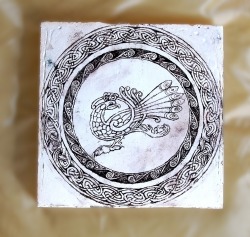
 As a diversion from the mainly Mesoamerican theme of late, this is a Peacock themed Celtic pattern, drawn from three different sources and recombined here.
1 Comment
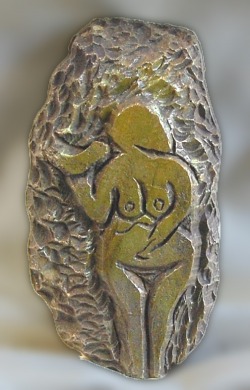 This was almost an afterthought. I had some concerns about the stability of the rubber moldmaking compound (it was getting old), so I took a scrap of plaster that was lying around to use as a test piece. It was drawn and carved in about fifteen minutes. Turned out the rubber was still good. The Venus of Laussel is a Venus figurine, a 1.5 foot high limestone bas-relief of a nude female figure, painted with red ochre. It is related to Gravettian Upper Paleolithic culture (approximately 25,000 years old). The figure was rediscovered in 1911 by J. G. Lalanne, a physician. It was carved into large block fallen in a limestone rock shelter (abri de Laussel) on the territory of the commune of Marquay, in the Dordogne department of southwestern France. It is now in the Musée d'Aquitaine, in Bordeaux, France.  Temple Mayor Museum AD 1400 This is the ink drawing on plaster.  This sculpture, 10 feet in diameter, is one of the most impressive and important examples of Aztec art. Her name is Coyolxauhqui, which means "She of the Rattles on her Cheeks". She was a daughter of Coatlicue and the ruler of the Centzon Huitznahuas, the star gods. She was a powerful magician and led her siblings in an attack on their mother, Coatlicue, because she became pregnant in a shameful way (by a ball of feathers). Coatlicue's fetus, Huitzilopochtli, sprang from her womb in full war armour and killed Coyolxauhqui, along with many of the brothers and sisters. He cut off her limbs, then tossed her head into the sky where it became the moon, so that his mother would be comforted in seeing her daughter in the sky every night. She was one of the major goddesses in Aztec mythology. In a mythical representation of the triumph of the sun over the powers of night personified by Coyolxauhqui as a lunar goddess, she is shown decapitated and dismembered after she was slain by her brother, the Sun God, Huitzilopochtli. Here, bells decorate her cheek, and she wears a skull on her belt. 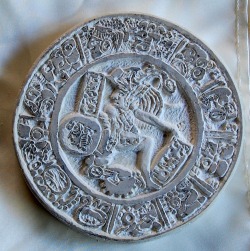 In keeping with current themes, this is more Mayan sculpture in the form of a football player. My version is 5" in diameter and will weigh 1 1/4 pounds. Palenque, Mexico 590 A.D. Surrounded by hieroglyphs, an ancient ball player demonstrates his skill and strength. The player's ability to manipulate and move the ball into stone rings, without the use of hands, was played to honor the gods with skill. The ball game represented the movements of the heavens for many pre-Hispanic peoples and, for the Maya, the game (called Ulama) had a religious significance. The ballplayer's solar headdress identifies him as one of the Hero Twins from the Maya epic Popol Vuh. It is generally believed that there were probably two version of the ball game. One was played as a sport, and probably had some betting involved. The other version was a religious re-enactment of the story of the Hero Twins in the Popol Vuh. In this case, there were probably only 2 players and the winner and looser were pre-determined. The looser was probably a captive, or a criminal. He would have been in terrible physical condition from going a long time without food. Perhaps he was even drugged. His purpose was to make the other player look good, probably a war hero or a young prince. People would have come to this event to cheer on the hero and deride and humiliate the captive, meanwhile preserving the ancient story of the Hero Twins. 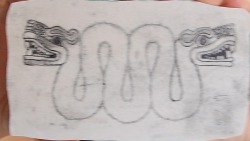 Pictured here is a cast stone sculpture of a Maya Double Headed Serpent. The dimensions are 4" wide x 3" tall and it weighs about 1 pound. British Museum, London. 15th century Splendid relic of the Aztecs, who rose from squalid origins to power and riches in just 200 years, this double-headed rattlesnake serpent was used as a ceremonial chest ornament that may have been worn by a priest. It is encrusted with scales of turquoise, a stone the Aztecs imported from the outposts of their empire to adorn some of their most beautiful possessions. This piece is the work of a Mixtec jeweler, and dates from the 15th century. 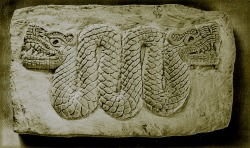 Finished plaster carving 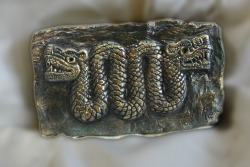 Once cured, I processed this sculpture with black pigments and Moss Green dye and gave it "Glorious Gold" highlights. A metal hook is embedded in the back, and it can be hung indoors or out. The mineral oxide pigments are 100% permanent and lightfast. The piece is further protected by a UV barrier coating. Signed and numbered in wet concrete on back. 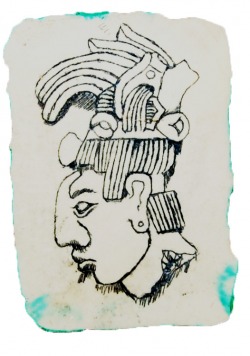 This is Maya King Pacal. The dimensions are 3" wide x 4" tall. Palenque, Mexico. 692 A.D. King Pacal (also known as Pacal the Great) was born in the year 603 A.D. He was king of the Maya Kingdom of Palenque and is said to have reigned for 67 years until his death at the age of 80. The name "Pacal" means "shield" in the Maya language. Pacal expanded Palenque's power in the western part of the Maya states, and initiated a building program at his capital that produced some of the finest art and architecture of the Maya civilization. He accended the throne at age 12 on 29 July, 615 A.D. After his death, Pacal the Great was worshiped as a god, and said to communicate with his descendants.  This is the first casting. Once cured, I processed this sculpture with rose dyes and gave it metallic gold highlights in the outer ring and Moss Green aniline dye and metallic silver highlights on the center portion. 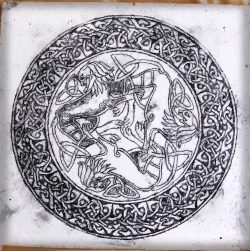 The design comes from a combination of sources, one a traditional pattern often involving three animals, be they dogs, eels, or lions. 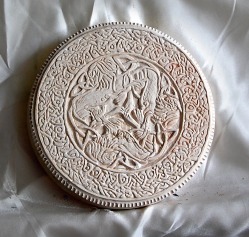 model complete 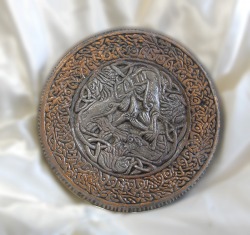 I processed this sculpture with rose dyes followed by silver highlights in the center and blue dye in the outer ring followed by metallic antique gold highlights  This is the initial ink drawing on plaster. 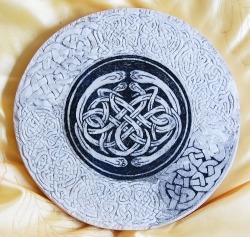 end of day 1 for this carving 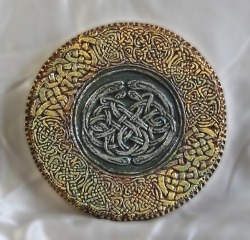 The design comes from a traditional pattern often involving three animals, be they dogs, eels, or lions. This example has been cast from a mold I made of my original plaster carving. I used a combination of mineral oxide pigments added to C-144 masonry sand and blends of white and gray portland cements, and then hand cast the piece in my home studio. Once cured, I processed this sculpture with rose and black dye in the outer circle and black and green dye in the center, then gave it metallic silver highlights in the center and gold highlights in the outer ring. 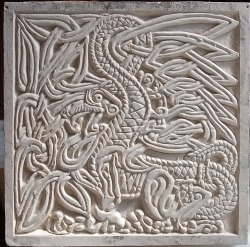 plaster model. This design combines the elemental power of a dragon with Celtic knot motifs. Celtic dragons often live at the bottom of deep lakes or guard trees. In Britain, the dragon is now more commonly associated with Wales, as its national flag features a red dragon (Y Ddraig Goch). 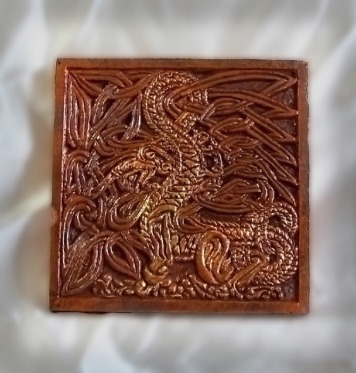 This example has been cast from a mold I made of my original plaster carving. I used a combination of mineral oxide pigments added to C-144 masonry sand and blends of white and gray portland cements, and then hand cast the piece in my home studio. Once cured, I processed this sculpture with a dark blend of dyes and gave it metallic gold over copper highlights. A metal hook is embedded in the back, and it can be hung indoors or out. The mineral oxide pigments are 100% permanent and lightfast. The piece is further protected by a UV barrier coating. |
Archives
October 2018
Categories
All
|
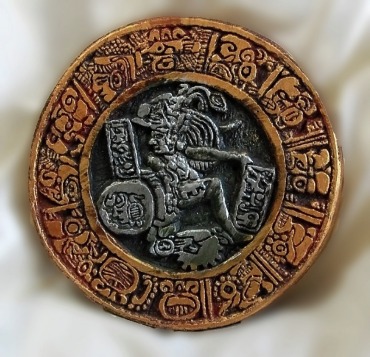
 RSS Feed
RSS Feed
